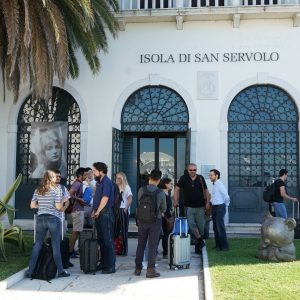
For more impressions click here!
The ingredients for the first e-conversion conference had been just perfect: around 120 motivated participants, top-level speakers from all over the world, warm September sunshine and as venue an ancient monastery on the island San Servolo in the Venice lagoon. The buildings on San Servolo now house the Venice International University (VIU) where e-conversion was able to organize its first conference from September 9-13, 2019. Visit the image galleries!
The focus of the meeting was on the scientific exchange between the members and about 70 PhD students of the cluster, and a unique line-up of top-level external speakers. „Our cluster e-conversion doesn´t live in isolation somewhere in free space“, remarks Karsten Reuter, one of the three cluster coordinators. “We need to know what is done all over the world and in comparable kind of centers. And so we have asked our most distinguished colleagues from all over to educate us what is going on in their kind of frontier research.“ Yet, the current conference and the ones to follow shall also serve another purpose: Being a signal to the scientific world as Reuter formulates: „It is also important that the others know that we exist now. That we are a new player on the field.“
What´s going on in energy conversion?
Following the cluster’s broad and integrative research focus, the scientific talks covered a wide range of energy conversion technologies. Latest advances in perovskite-based solar cells were discussed, as was progress on suppressing dendrite formation in all solid-state batteries. More fundamental contributions centered on the role of chirality and spin, or on using plasmonic nanoparticles as energy converters. This was contrasted by talks that described the state-of-the-art in scalable (electro-)chemical energy conversion technologies like electrolysis, CO2 reduction or ammonia synthesis. The range of methodologies covered extended from interface engineering and characterization to frontier use of modern machine learning approaches. The overview talks by the international experts were thereby nicely complemented by contributions from members of the cluster, in particular from emerging scientists and new members that were only recently appointed at the Munich universities.
Plenty of time for discussions
When planning the program the cluster coordinators had deliberately included plenty of time for informal scientific discussion: a welcome reception in the idyllic monastery courtyard, two poster sessions and long enough breaks between the talks. Many members of the still young cluster took the chance to get to know each other beyond faculty and university borders. For the PhD students and PostDocs the informal exchanges had a particular significance. Here they were able to discuss their projects with some of the best-known scientists in the corresponding discipline. As for PostDoc Batyr Garlyyev: “I work in electrocatalysis and for me it was really special to see Ib Chorkendorff and Jens Nørskov from Denmark. They are the leading people in this field.“ PhD student Theresa Grünleitner has benefited too: „I´m growing molybdenum disulfide and there were other people growing different materials, but you can exchange experiences, what measurements they do and how we might improve.“ Also the external speakers enjoyed the lively discussions and the very special atmosphere of the conference and the venue. For Prof. Justin Gooding from the University of New South Wales in Sydney the long travel was definitively worth it: „What I see here is high-quality work being done, answering and trying to adress important questions related to clean energy sources. And the thing that really resonates with me is the incredible depth people are going to.“
See you in 2020!
The three coordinators of the e-conversion cluster, Prof. Karsten Reuter, Prof. Thomas Bein and Prof. Ulrich Heiz were highly pleased with the course of the conference. Thomas Bein summarized proudly “This was a remarkable kick-off for our cluster that already created a very special atmosphere and overall team spirit. As the next step, we will now have a series of more focused workshops that will then deepen the understanding and collaboration in the various research areas. For instance, the next workshop on hot carrier dynamics in advanced solar cells is already taking place in the end of October.” The next general e-conversion conference is also already in the planning. It will take place from September 8-11, 2020 close to Burghausen in Bavaria. Once again the participants can look forward to a very special venue: the more than 800 years old monastery Raithenhaslach – a “baroque jewel at the gates of the city”.
